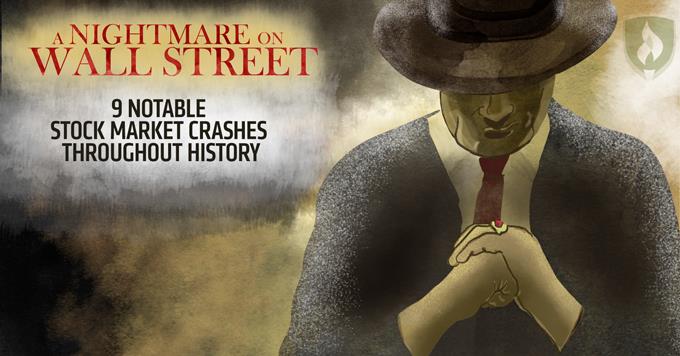Nightmare on Wall Street: 9 Notable Stock Market Crashes Throughout History
By Megan Ruesink on 11/03/2016

Another Halloween has come and gone. You’ve seen your fair share of spooky masks and creepy costumes, and of course indulged in lots of bite-sized candy. But the real scary stuff wasn’t walking around your neighborhood asking for treats. Imagine seeing an entire economy collapse, panic ensuing all around you, mass unemployment and worse. The really scary stuff happens when the stock market crashes.
In the wake of Halloween, we’re reliving some of the scariest stock market crashes in U.S. history. Whether you’ve been in finance all your life or you’re just interested in a little history lesson, learn a bit about nine notable stock market crashes, what caused them and how they affected our nation and world.
But first… what constitutes a stock market crash?
“A stock market crash is usually defined as a sharp decline in the value of a broad range of stocks,” says Christopher V. Kimball, CFP. “This is, of course, an oversimplification, and there are a myriad of factors that can cause such an occurrence.”
And though each crash is different, as Vic Patel, professional trader and founder of Forex Training Group puts it, “they are eerily similar as well.”
So before we dive into these stock market crashes, here are some basic characteristics of a crash. A stock market crash usually:
- Is unanticipated
- Is a double-digit percentage drop in an index
- Happens quickly (over the course of a few days, though can lead to years of damage)
- Follows the collapse of a speculative bubble, economic crisis or catastrophe
- Is made worse by public panic
9 memorable stock market crashes
Now that you’ve got a handle on the basic characteristics of a crash, check out these nine nightmare-ish crashes, and hope that nothing this freaky hits our economy again any time soon.
1. Panic of 1857
After a season of prosperity, widespread embezzlement led to the failure of the NY City branch of the Ohio Life Insurance and Trust Co. This, along with other contributing factors, kicked off what is known as the panic of 1857, which in turn led to a year and a half depression. In less than this time, more than 5,000 American businesses failed, with the European, South American and the Far East economies feeling the effects as well. Full recovery wasn’t until years later.
2. The crash of 1869
Also known as Black Friday, this day in history is steeped in scandal. Because, unlike many crashes, this one can be traced back to a few key connivers, Jay Gould and Jim Fisk. The financiers had a plan to buy up as much gold as possible, let the price inflate and then sell. But when the government went ahead and sold 4 million in gold, the price quickly plummeted, panic and pandemonium followed as investors rushed to sell their holdings. Unfortunately, Gould escaped the consequences and was not among one of the many people who were ruined in this crash.
3. Panic of 1901
This market crash is notable because it was the first to occur on the New York Stock Exchange. Caused primarily by financiers E. H Harriman, Jacob Schiff, J.P Morgan and James J. Hill who were struggling for financial control of the Northern Pacific Railway. As prices fell throughout that fateful day, panic-selling ensued and many smaller investors came to ruin.
4. Panic of 1907
Also known as the Bankers’ Panic or Knickerbocker Crisis, this crash was initiated by a failure to corner the market and the subsequent downfall of numerous banks and trusts (included the Knickerbocker Trust Company). Bank runs and widespread panic contributed to the NY Stock Exchange falling almost 50 percent. J.P. Morgan and other financiers stepped in, helping to shore up the banking system. At the time, there was no central banking system to restore liquidity into the market. This crash, among other issues, helped lead to the creation of the Federal Reserve.
5. The crash of 1929
With the economic boom of the twenties, October 24, 1929 hit the economy hard, with the Dow Jones falling 28 points. Fear, panic and clogged lines of communication led to massive sell orders, and within a few weeks the market had seen a cumulative drop of 40 percent! The Dow Jones would continue to spiral downward, hitting bottom in July 1932, having lost 89 percent of its value. This crash was a large contributor to the Great Depression, which affected not only the U.S. economy, but much of the globe.
6. The crash of 1987
Also known as Black Monday, this crash is probably most well known for being the largest percentage decline in the Dow Jones in a single day—falling 22.61 percent! The cause of this crash? Many point the finger at program trading, computerized trading programs that, though well-intentioned, ended up fueling the fire and making matters much worse than they probably would have been.
7. 1990-1991 Recession
This event is seen as more of a recession than a crash, but in some ways has similar markings. The recession was primarily initiated by the Iraqi invasion of Kuwait and subsequent oil price shock of 1990. Oil rose from around $17 per barrel to $36 per barrel in a few short months. Coupled with a weak economy, and the Federal Reserve tampering with interest rates, a recession followed; around 1.6 million jobs were lost, and unemployment peaked in June 1992 at 7.8 percent.
8. Dot Com Bubble Burst
The Dot Com Bubble was a result of a rapid rise in equity markets as venture capitalists poured funding into internet startups without regard to traditional investing fundamentals. After the NASDAQ index peaked on March 10, 2000, many of leading tech companies placed enormous sell orders on their stocks, which incited panic among other investors. Companies that had seen tremendous market growth were worthless in only a few months and literally trillions of investment dollars were lost.
9. 2008, The Great Recession
For most of us, the Great Recession is a time-period we remember all too well. Officially lasting from December of 2007 through June of 2009, the recession began with the housing bubble bursting. The loss of consumer spending and investments lead to the loss of 8.4 million jobs, 6.1 percent of all payroll employment and recovery was extremely sluggish— with 5.4 percent fewer jobs in 2010 than before the recession.
Capitalize on your curiosity
Your interest in stock market crashes suggests you might just be cut out for a career on Wall Street. Learn about some other indicators that you have what it takes to work in finance in our article: 8 Signs You Have What it Takes to Major in Finance.
RELATED ARTICLES:




